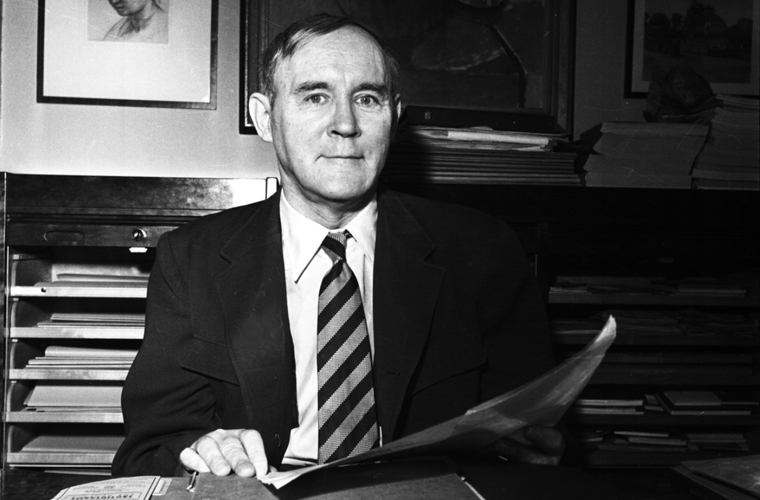Gunnar Dahlberg was the son of Henning Dahlberg, a vicar, and of Gertrud Jaede Dahlberg. He graduated from secondary school at Västervik in 1911 and studied medicine at Uppsala University under the anatomist J. V. Hultcrantz. He received his M. D. in 1926, and until 1936 he was assistant professor of medical genetics and medical statistics at Uppsala. From 1936 until his death he was director of the Swedish State Institute for Race Biology. In 1919 he married Stina Westberg, a physical therapist who during the 1920’s was employed at the institute: they had one daughter.
Dahlberg’s importance is threefold: he was a creative scientist, an influential teacher, and an outspoken critic of German Rassenhygiene. His doctoral dissertation dealt with a classic subject in the naturenurture debate: Twin Births and Twins from a Hereditary Point of View (1926). It discusses the frequency of twin births in different nations and among different classes, and describes in terms used by physical anthropologists differences in size, hair texture, and so on. Then and later the amount of his laboratory work was slight, and statistical methods were used to an unusual extent. After his dissertation and several shorter papers, Dahlberg edited Herman Lundborg’s comprehensive description of the Swedish Lapp population (1941), purging it, however, of ethnographical detail Mathematische Erblichkeitsanalyse von Populationen (1943) is the prime example of Dahlberg’s ability to criticize the optimism of Rassenhygiene through statistical analysis. For example, he believed there is no point in sterilization for eugenic reasons, since hereditary illnesses often make the carrier incapable of reproduction from an early age.
Shortly after graduation, Dahlberg started an informal “doctoral school” in which medical undergraduates were trained mainly in the statistical method and the fundamentals of genetics. Even before he had become director of the Swedish State Institute for Race Biology, he had been the adviser for some twenty doctoral dissertations. By the time of his death the number had quadrupled. Dahlberg’s main contribution was expert information on medical statistics, about which he published two introductory books (translated into English as Statistical Methods for Medical and Biological Students [1940] and Race, Reason, and Rubbish [1942]). He profoundly influenced Swedish medical education by establishing the necessity of statistical training.
Dahlberg joined the Swedish State Institute when it opened in 1922. However, he soon came to disagree on most questions with its director, Herman Lundborg. When Lundborg was due to retire, he did his best to stop Dahlberg from succeeding him. Theselection committee seemed to favor Dahlberg’s rival, but after two years of strife Dahlberg was appointed to the chair. He fought his way, at times perhaps using somewhat dubious means, but there were fundamental human principles involved. Lundborg was sympathetic to the German Rassenhygiene, whereas Dahlberg had written against it. It is no wonder, then, that Dahlberg wanted to see Nazi supporters disqualified as judges in this affair.
This competition turned Swedish race biology and genetics away from their German leanings. Dahlberg continued to criticize the unscientific character of Rassenhygiene, and during World War II he constantly challenged its Swedish supporters. He had good relations with British scientists, among them the medical statistician Lancelot Hogben, who shared his socialist views and also translated his works. When Herman Muller left the Soviet Union in 1937, Dahlberg offered him a position at the Institute of Race Biology. Dahlberg’s active opposition to Rassenhygiene during the war and his genetic expertise made him a natural choice for the UNESCO committees of 1949 and 1951 that reformulated the race concept to stress the unity of mankind. To Dahlberg “race” had no real biological meaning but merely obscured constantly changing statistical entities; hence he viewed “race biology,” as a medical rather than an anthropological science.
Dahlberg had obvious problems in completing extensive investigations, preferring to toy with ideas. His format was the essay. Dahlberg’s survey of the state of genetics. Arv och ras (Race, Reason and Rubbish), was a brilliant synthesis, while others of his books were more casual. Something of his attitude toward himself and toward science is revealed in the title of one of his volumes, Dit min tanke nått (“As Far As My Thought Has Reached;” 1943). He won a relatively wide audience for modern genetics through his published works but never involved himself in legislate e committees or party politics. His ideas, however, had great influence on his friend Gunnar Myrdal. who, with his wife, Alva, transformed the race question into a concern of the modern welfare state (Kris i befolkningsfrågan, 1934).
Dahlberg was very much a man of thought rather than of action, Despite his socialist convictions, he was an aristocrat at heart, and despite his training as a geneticist, he was no specialist but a generalist. A time-consuming aspect of his wide interests was his lexicographic work. With Herbert Tingsten, the leading liberal intellectual of his day, he edited and wrote Svensk politisk uppstagsbok (Swedish Political Encyclopedia, 1937), and alone he compiled Tidens lexikon (1950), a work of three thousand pages.

